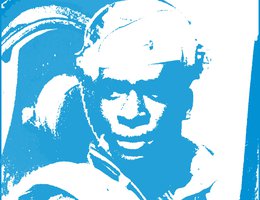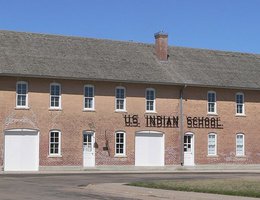
Image

By Capitolist (Own work) [CC BY-SA 4.0 (https://creativecommons.org/licenses/by-sa/4.0)], via Wikimedia Commons
Image

1925-1949 timeline image - The War - Nebraska Stories of War
Image

Genoa Indian School, The facility was completed in 1884 and operated until 1934. Now restored, it is owned and operated by a foundation as the Genoa U.S. Indian School Museum.
Web Page
Web Page
Imagine that you could be transported in a time machine to Nebraska 12 million years ago. You would walk out of your time machine into a very different world than the one you’re used to.
For one thing, you would be the only human being in the landscape. Humans had not yet evolved, and so animals dominated a landscape covered with sub-tropical grasses and patches of jungle.
The area that became Nebraska ... Read more
Web Page
After millions of years of moving from one place on the globe to another, after millions of years covered by a shallow inland sea, and after millions of years covered with tropical jungles and savannas, what would become the northern Great Plains was plowed under by a series of huge sheets of ice that pushed down from the North Pole and then receded. The glaciers were pushed across the northern plains by the weight ... Read more
Web Page
The first recorded contact between Europeans and native people on the Central Plains came between the Spanish and the Wichita tribe in what is now Kansas. Contact with the French and the British came decades later. Contact with the Americans came a century or more later still. Very slowly at first, but inexorably, these contacts would change the lives of native people.
Christopher Columbus landed on an island ... Read more
Web Page
Throughout the 1700s, the nations of Europe played out political dramas on the plains of Nebraska. Successive expeditions would venture forth and negotiate with the plains tribes, offering symbolic gifts — certificates heralding "peace and friendship," peace medals, canes and flags. Towards the end of the century, the gifts given by the Spanish to tribes west of the Mississippi River cost that one colonial power over $100,000 a year. The goal of the whites was to establish alliances and dominate ... Read more
Web Page
For centuries before 1800, Native tribal groups had inhabited the land of the Great Plains and the West. In that sense, they "owned" it. Between 1650 and 1800, a series of European governments — Spain, Britain, France and Russia — all sent explorers into parts of the West and "claimed" to own the land.
But in 1802, ownership of a large part of the West changed, and changed fundamentally. ... Read more
Web Page
The first Europeans to see the West were soldiers, explorers, mountain men, trappers, and traders. At first they followed the rivers and streams into the West, but eventually most realized that rivers couldn’t take you everywhere you wanted to go. And so overland routes were blazed.
Fur traders were among the first white men to follow Indian trails that eventually became a blueprint for parts of the Oregon Trail. They ... Read more
Web Page
The first half of the 19th century was a time of great change on the Great Plains. It was only 1803 when President Jefferson completed the Louisiana Purchase from Napoleon — a purchase including the Great Plains region. No one knew what was in the purchase besides a lot of land and relatively few Indians. This land was not organized into a territory. In 1854, the federal government passed the ... Read more
Web Page
Imagine yourself as a young person in a place where the land has all been taken. You might want to become a farmer, but there is no farmland available. Then imagine seeing advertisements for land, some for very little money, some for free! You face many unknowns. What is this new land really like? Will there be enough rainfall to grow your crops? Will you have neighbors? Who will they be? What about the people who are already on the ... Read more
Web Page
Notable Nebraskan, Julius Sterling Morton was born April 22, 1832 in Adams, New York. Morton, along with Robert Furnas, was the co-founder of Arbor Day.
At a young age, Morton knew he loved newspapers and nature. He pursued these passions throughout his life and today is known for both.
After finishing school at the University of Michigan, Morton married ... Read more
Web Page
Several events caused an increase in the number of cattle in Nebraska after the Civil War. The destruction of the Plains bison made more room for cattle, and Native Americans needed a new meat source. Meat-processing plants in Chicago and gold miners rushing to the Black Hills needed beef. The enormous growth in the beef industry caused many changes and challenges.
In the 1870s, Americans’ taste for beef became more refined. ... Read more